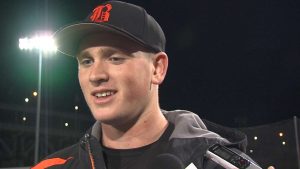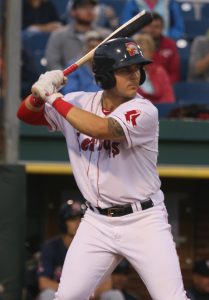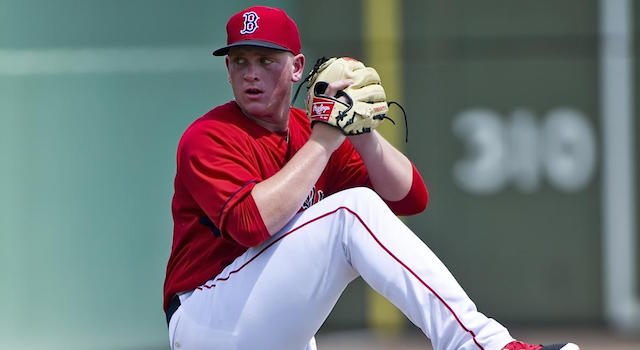Baseball America released its annual top 100 prospects list Monday. If you go searching for Red Sox, it might take you awhile. The Red Sox have two of their prospects included on the list, and both are in the bottom twenty. What happened to the Red Sox system you might ask? Well, they traded away a lot of their young assets, but most of the deals have worked out. Some of them were dealt to Chicago for staff ace Chris Sale, others were sent to San Diego for Craig Kimbrel and Drew Pomeranz. Others are just no longer eligible, as Andrew Benintendi and Rafael Devers are on the big club. The Red Sox still have plenty of young talent, as for the farm system; let’s take a look at the two who made the list.
Jason Groome
Groome, unsurprisingly, is the highest Red Sox on the list. What is a bit surprising is him coming in as low as eighty-third on that list. Groome was a top prospect coming into the 2016 draft, some places even ranked him as the best eligible player in the draft. He fell to the Red Sox at twelfth, presumably due to signability issues and minor character concerns. The Red Sox got a bargain, having arguably the best talent in the draft slip to them at twelve. And as a left-handed pitcher with ace potential that was like striking gold.
Groome is a big kid, standing at 6’6″ 220. At just nineteen years old, he has room to add to his frame and maybe pick up a couple of ticks on his fastball velocity, which already reaches the mid-90’s. There is no real concern over his body, as it is a great size to withstand the rigors of pitching all season long and approaching 200 innings a year. Groome also has the makings of a devastating curveball, which Keith Law said was the best in the entire 2016 draft class and one of the best he had ever seen from a high schooler.
Work Left to Do
Groome still has work to do; he is only nineteen years old after all. He needs to work on his mechanics and his control as he walked 4.9 batters per nine innings last season. Groome also needs to improve his changeup to give himself a reliable third pitch. It is hard to make it as a starter in the big leagues with only two pitches, so the development of a third pitch is key. He has the talent to do so, pitching in high school there was no need for him to ever throw a changeup because no one could hit his fastball and curveball. With some work, I expect his changeup to become at least adequate with time.
The reason Groome likely slips to number eighty-three on the prospects list is due to his disappointing 2017 campaign. In all fairness to Groome, he was injured right out of the gate and played catch up for most of the year. Groome took a shellacking in his debut at Greenville and didn’t pitch again for over two months. He made three rehab starts at Lowell, finishing up with a five inning no-hitter. After making it back to Greenville Groome showed inconsistency, pitching a couple stellar games but also exhibiting his control problems in others. He was just 3-7 with a 6.70 ERA at Greenville, but throwing out that first start in which he was injured, the ERA comes down to 5.02. For a positive, Groome struck out 11.77 batters per nine innings at the level.
Moving Forward
A good sign for Groome’s development is he worked out with Chris Sale in the offseason. The Red Sox top prospect, a left-hander, taking the initiative to work out with fellow left-hander and staff ace can only be a good thing. I think if Groome can enter this season healthy he will show a lot more of his potential and show why he was so highly though of out of high school. He has already shown the ability to miss plenty of bats, I think he will put that to better use this season. With it, Groome should fly up the prospect rankings by season’s end. If things go well, he may even threaten the top twenty next year.

Groome grew up a Red Sox fan despite living in New Jersey surrounded by Yankees fans.
Michael Chavis
Chavis came in at eighty-fifth on the prospects list, just two spots lower than Groome. As the top power bat in the Red Sox system, Chavis got a lot of attention last season. A first round pick back in 2014, Chavis struggled adjusting to pro ball. Chavis started in Greenville in 2015 and only batted .223. The only positive of his debut were the sixteen home runs he hit. At just twenty years old the Red Sox had Chavis repeat the level in 2016, and it didn’t go any better. For a first round pick, Michael Chavis was certainly not living up to expectations.
2017
Chavis entered the season last year at twenty-one years old. He also opened the season with high-A Salem, a team he had only played for briefly towards the end of the 2016 season. Chavis showed immense improvement, not only hitting for power, but for average as well. In 223 at-bats with Salem, Chavis hit .318 with seventeen long balls and a 1.029 OPS. He was beginning to show why the Red Sox had made him a first round draft pick three years earlier.
The performance earned Chavis a mid-season callup to AA Portland. Although his bat slowed some, Chavis still exhibited the power potential he had shown in Salem earlier in the year. His average dropped to .250 in Portland, but he still managed a nice .802 OPS. In 248 at-bats he added fourteen more home runs for the Sea Dogs, giving him thirty-one on the season between the two levels. Playing in the Arizona Fall League, Chavis’ numbers remained in line with what he had done in Portland, batting .261 with four home runs and an .805 OPS. Thirty-five home runs in 563 at-bats is a nice year’s work.

Chavis batting with the Portland Sea Dogs.
What’s To Come
Can Chavis be the hitter he was in Salem, hitting for a good average and power? Or will he be a power hitter who struggles to make contact and hit for a mediocre average? The evidence so far leads me to believe he will be closer to the player we saw in Portland then the one with Salem. Hey, there’s a market for power bats, it’s not a bad thing. Even when going well, Chavis has some swing and miss to his game and hasn’t walked a ton. Last year he drew 39 walks against 113 strike outs. It would be nice to see him walk more by the time he makes it to the Major Leagues. Then again, sometimes guys hit the ball with more authority when they have an aggressive approach.
Chavis’ defense at third base is a little questionable, but if Rafael Devers shows improvement at the hot corner the Red Sox are set there for years to come. The ultimate home for Chavis on the diamond might be at first base, where the Red Sox don’t have anyone locked up past 2019. With Mitch Moreland and Hanley Ramirez back in the fold, the Sox shouldn’t need Chavis this year. They even have Sam Travis, who Baseball America rated as the Red Sox seventh best prospect. With another season like 2017, he might force his way up for 2019, but he needs to focus on continual improvement to his game first. Chavis has some work to put in down on the farm, as Major League pitchers will do a better job finding the holes in his swing and exploiting his weaknesses.
Feature picture from Baseball Hot Corner
